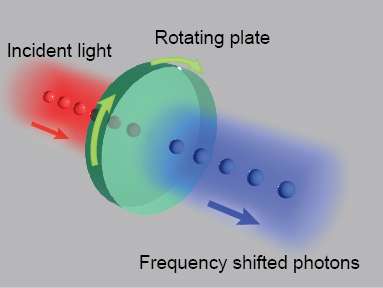Nonlinear rotational Doppler effect in light observed for the first time

Experimental physicist Prof. Thomas Zentgraf and his two colleagues from the University of Birmingham, Dr. Guixin Li and Prof. Shuang Zhang, have for the first time proved experimentally the nonlinear rotational Doppler effect of light—nearly 50 years after its theoretical prediction by the Dutch Nobel Laureate Nicolaas Bloembergen.
The acoustic Doppler effect can be experienced day in the real world every: An ambulance siren sounds sharper closer to the emergency vehicle; when the vehicle pulls away, the siren sound descends. This is due to the change of wavelength of the sound waves, which are compressed or stretched during the movement of the sound source, thus changing its pitch. The effect applies to all kinds of waves, including light waves. Similarly, as a star moves away from Earth, its emitted light wave is stretched, creating the so-called red-shift, i.e. a longer wavelength of light.
Conversely, a light wave emitted from a star approaching Earth will be compressed, which causes a blue shift. In 1842, the Austrian physicist Christian Andreas Doppler predicted this optical effect in his paper "On the colored light of the double stars and certain other stars of heaven," and presented this phenomenon to the Royal Bohemian Society of Sciences in Prague. Three years later, the Dutch physicist Christoph H. D. Buys-Ballot observed the acoustic Doppler effect in a spectacular experiment. He used the fastest transportation tool at that time—the railway. A musician was playing trumpet on a moving rail car while musicians standing next to the track listened to the tones he played. The displacement of the pitch in the tones they heard as the train passed by is equivalent to the predictions for Doppler's color shift of light.
Today, the Doppler effect has made possible a number of technological achievements in fields such as speed measurement via traffic cameras, GPS, and the ultrasound measurement of blood flow velocity in the human body. In addition, the Doppler effect plays a key role in such important quantum phenomena as the broadening of spectral lines and the trapping and cooling of atoms with laser light.
In addition to the well-known Doppler effect for translational movements, there is also a rotational Doppler effect for rotary motion of objects. This effect leads to a shift of wavelength depending on the rotational speed, and can be used in the measurement of rotational frequencies of air turbulence, molecules and astronomical objects.
In 1968, a few years after the invention of the laser, a new rotational Doppler effect was predicted by Nobel laureate Nicolaas Bloembergen for rotating objects under the high intensities of illumination of laser light—a nonlinear rotational Doppler effect. Nearly 50 years later, this effect was demonstrated for the first time in the laboratory.
"Due to the small wavelength shift for this non-linear effect, it is extremely difficult to observe it directly in an experiment," explained Prof. Thomas Zentgraf. This is due to the low rotational speed of objects compared to the speed of light. This means that the wavelength shift of light as it passes through a rotating object is in the range of a few trillionths of the wavelength itself. Even in the laboratory, such a small wavelength shift cannot be measured directly. "We have used a special superposition between two light waves, called interference," explains Prof. Zentgraf. The change of this superposition was detected; from this, the wavelength shift was determined.
This poof of a fundamental effect of physics represents an important step in the examination of current theories. With the experiments at the University of Paderborn and the University of Birmingham, one further prediction has now been confirmed. In the future, this effect could find broad application in the study of turbulence, laser plasmas and the rotational property of molecules.
The original paper has been published in the journal Nature Physics.
More information: Guixin Li et al. Rotational Doppler effect in nonlinear optics, Nature Physics (2016). DOI: 10.1038/nphys3699
Journal information: Nature Physics
Provided by University of Birmingham



















